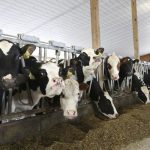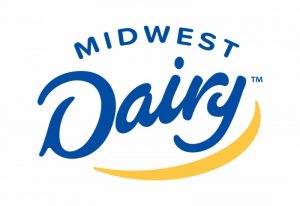
NMPF President and CEO Jim Mulhern stated, “As most of the country shelters in place and large swaths of the foodservice sector come to a standstill, dairy sales outside retail channels have plummeted. Market prices have fallen rapidly, creating a crushing economic outlook for producers of nutritious, and necessary, milk and dairy products.”
“The goal is to help offset the steep decline in farm milk prices and encourage producers to reduce excess supply resulting from demand disappearance,” the statement says, by paying producers $3 per hundredweight on 90% of their production, if they cut production by 10% from a March 2020 baseline.
The proposal calls for a loan program for processors as well as a dairy product donation program, with the government purchasing $525 million worth of butter, cheese, fresh and powdered milk to give away. The proposal also calls for loosening packaging requirements for the Women’s, Infant’s and Children’s (WIC) programs and re-opening Dairy Margin Coverage for dairy farmers.
Milking red ink
Hemorrhaging continued in the dairy markets in the “April Fool’s Day” Week, due to the COVID-19 epidemic, and continues this week, triggered by what FC Stone’s Dave Kurzawski called “colossal disruptions to the entire dairy supply chain. Restaurants push back on distributors. Distributors push back on manufacturers. Manufacturers push back on producers, and producers dump milk in the lagoon.”
The Cheddar blocks, after nine consecutive sessions of decline, closed the first Friday of April at $1.15 per pound, down 44 cents on the week, after losing 24.75 cents the previous week, and hit the lowest price in 11 years and 51 cents below a year ago.
The barrels saw a Friday close at $1.1375, 20.25 cents lower on the week, lowest since July 2009, and 43.75 cents below a year ago.
Monday’s block price was down 2.25 cents, as traders anticipated Tuesday morning’s Global Dairy Trade, and stayed there Tuesday at $1.1275, lowest since July 15, 2009.
The barrels were down 4.75 cents Monday but perhaps encouraged by the morning’s GDT, gained a penny Tuesday on an unfilled bid, first positive move in 10 sessions, and hit $1.10 per pound, a more normal 2.75 cents below the blocks.
It will be a short week, due to the markets being closed for Good Friday. Milk is plentiful in the Midwest, reports Dairy Market News, and cheese markets are “resolutely bearish due to precipitous drops on the CME.” Managers are in limbo when it comes to taking on extra milk and scheduling production.
Retail cheese sales in the West continue to be strong but are down from last week. Orders from food service and international buyers are stable to lower.
Cheese outputs are steady but milk is abundant.
Butter’s meltdown also continued, closing Friday at $1.28 per pound, down 20.75 cents on the week, and followed losses totaling 36.75 cents the previous 3 weeks and 99 cents below a year ago; 22 cars were sold last week at the market of last resort and 38 on the month, down from a whopping 231 in February.
The butter was down 2.5 cents Monday, slipping to $1.2550, lowest it has been since Oct. 19, 2009, but it regained a penny Tuesday, inching back on an unfilled bid to $1.2650, first positive move in 12 sessions.
Food service demand is bleak, warns DMN. Retail ordering is still firm but with lighter restaurant and little to zero orders into educational institutions, butter inventories are growing. “While ice cream manufacturers and other plants that normally take on cream are running skeleton crews or even closed, the onus of current cream inventories falls on butter makers.”
Western butter makers say offers for cream are abundant but they cannot take on more risk. Churning is active and producers are making more butter than can be sold in the near term so stocks are growing. Pricing has become challenging. A price set one day could lose a sizable portion of its value the next trading day, says DMN.
Grade A nonfat dry milk saw its Friday close at 86.25 cents per pound, down 5.75 cents on the week, 12.5 cents below a year ago, and the lowest it has been since November 2018; 43 sales were reported on the week and 195 for March, up from 105 in February.
Monday’s powder was unchanged but jumped 3.75 cents Tuesday, to 90 cents per pound.
CME dry whey has been the one exception in the falling markets, holding at 33 cents per pound for 13 consecutive sessions, including Monday and Tuesday this week.
Poised to plunge
The Agriculture Department announced the March Federal order Class III price at $16.25 per hundredweight, down 75 cents from February but still $1.21 above March 2019 and the highest March Class III since 2014. The three-month average stands at $16.77, up from $14.30 a year ago, and compares to $13.87 in 2018 but that’s where the good news ends.
The COVID-19 outbreak has resulted in Class III futures being pulled sharply lower and Monday’s settlements had April at $13.88; May, $11.83; and June at $13.05, with the peak in October at $15.31, a price that weeks ago topped $17.00.
The Class IV price is $14.87, down $1.33 from February and 84 cents below a year ago and the lowest Class IV price since September 2018. Its three-month average is at $15.91, up from $15.68 a year ago and $13.01 in 2018.
GDT up 1.2%
Butter greased the gears in Tuesday’s Global Dairy Trade auction, resulting in its first positive move in five sessions. The weighted average of products offered inched up 1.2% on the smallest volume since June 4, 2019, but follows the 3.9% plunge on March 17, 1.2% drop on March 3, 2.9% on Feb. 18, and a 4.7% plunge on Feb. 4.
Butter led the gains, up 4.5%, after inching 0.3% higher last time, followed by lactose, up 4.4%. Whole milk powder was up 2.1%, after it fell 4.2% last time, and anhydrous milkfat inched 0.4% higher, after a 1.0% loss. GDT Cheddar was up 0.2%, following a 2.6% jump last time.
Buttermilk powder led the losses, down 11.9%. Rennet casein was down 2.6% and skim milk powder slipped 0.8%, following its 8.1% plunge on March 17.
FC Stone equated the GDT 80% butterfat butter price to $1.8864 per pound U.S., up 5.2 cents from the last event. CME butter closed Tuesday at a bargain $1.2650.
GDT Cheddar cheese equated to $1.9937 per pound and compares to Tuesday’s CME block Cheddar at an unbelievable $1.1275.
GDT skim milk powder averaged $1.1403 per pound and compares to $1.1462 last time.
Whole milk powder averaged $1.2793, up from $1.2687. CME Grade A nonfat dry milk closed Tuesday at 90 cents per pound.
Output still strong
You’ll recall February U.S. milk output, adjusted for “Leap Day,” was up 1.5% from February 2019. The USDA’s February Dairy Products report shows where the milk ended up.
February butter output came in at 179.2 million pounds, down 0.9% from January, when adjusting for the leap day, but 5.2% above a year ago, the ninth consecutive month output topped that of a year ago. Year to date butter is up 3.6% from 2019.
Cheese output totaled 1.03 billion pounds, down 1.0% from January, adjusted, but 0.1% above February 2019. That put the two-month output up 0.6% from a year ago.
American cheese totaled 415.0 million pounds, up 1.4% from January and 2.5% above a year ago, with YTD up 1.0%.
Mozzarella, at 353.6 million pounds, was down 1.0% from January, 1.7% below year ago, with YTD off 0.5%
Cheddar output, the cheese traded at the CME, was up 1.0% from January, up 3.7% from a year ago, with YTD up 1.2%
Dry whey for human consumption totaled 75.0 million pounds, down 3.0% from January and 1.7% below a year ago. YTD is up 1.0%. Stocks climbed to 73.7 million pounds, up 18.6% from January and 8.0% above a year ago.
Nonfat dry milk output totaled 156.1 million pounds, down 5.3% from January and 2.0% below a year ago, with YTD powder up 0.1%. Stocks climbed to 317.5 million pounds, up 37 million or 13.2% from January and were 7.1 million pounds or 2.3% above the 2019 level.
Skim milk powder amounted to 40.4 million pounds, up 7.7% from January and 9.6% above a year ago, with YTD up 5.2%.
Milk ratio dropping
A falling All Milk price pulled February’s milk feed price ratio lower for the third month in a row and the lowest since September 2019. The USDA’s latest Ag Prices report put the ratio at 2.34, down from 2.41 in January but compares to 2.07 in February 2019.
The U.S. All-Milk price averaged $18.90 per hundredweight (cwt.), down 70 cents from January but is $2.10 above February 2019.
The national average corn price averaged $3.78 per bushel, down a penny per bushel from January but 18 cents per bushel above February 2019.
Soybeans averaged $8.59 per bushel, down 25 cents from January but 7 cents per bushel above a year ago. Alfalfa hay averaged $171 per ton, unchanged from January but $9.00 per ton below a year ago.
The February cull price for beef and dairy combined averaged $65.80 per cwt., up $4.40 from January, $6.90 above February 2019, but is $5.80 below the 2011 base average of $71.60 per cwt.
























